1997 MERCEDES-BENZ ML500 oil
[x] Cancel search: oilPage 761 of 4133

294
Fuels, coolants, lubricants etc.
Te ch n ica l
data
Instruments
and controls Operation Driving
Instrument
cluster display Practical hints Car care Index
Engine oils
Engine oils are specifically tested for their suitability in
our engines. Therefore, use only engine oils
recommended by Mercedes-Benz. Information on
recommended brands is available at your authorized
Mercedes-Benz Light Truck Center.
Please follow Service Booklet recommendations for
scheduled oil changes. Failure to do so could result in
engine damage not covered by the Mercedes-Benz
Limited Warranty.
Engine oil additives
Do not blend oil additives with engine oil. They may be
harmful to the engine operation.
Damage or malfunctions resulting from blending oil
additives are not covered by the Mercedes-Benz Limited
War ra nt y. Air conditioner refrigerant
R-134a (HFC) refrigerant and special PAG lubricating oil
is used in the air conditioner system.
Never use R-12 (CFC) or mineral-based lubricating oil,
otherwise damage to the system will occur.
Brake fluid
During vehicle operation, the boiling point of the brake
fluid is continuously reduced through the absorption of
moisture from the atmosphere. Under extremely hard
operating conditions, this moisture content can lead to
the formation of bubbles in the system thus reducing
the system’s efficiency.
The brake fluid must therefore be replaced every two
years, preferably in the spring.
It is recommended to use only brake fluid approved by
Mercedes-Benz. Your authorized Mercedes-Benz Light
Truck Center will provide you with additional
information.
Page 762 of 4133
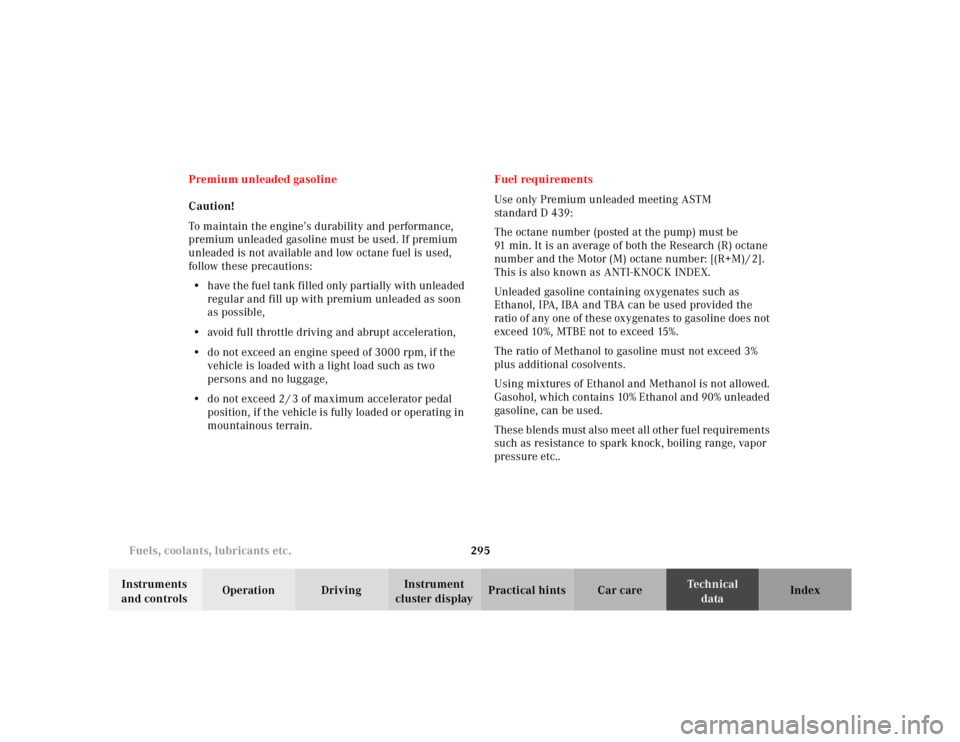
295
Fuels, coolants, lubricants etc.
Te ch n ica l
data
Instruments
and controls Operation Driving
Instrument
cluster display Practical hints Car care Index
Premium unleaded gasoline
Caution!
To maintain the engine’s durability and performance,
premium unleaded gasoline must be used. If premium
unleaded is not available and low octane fuel is used,
follow these precautions:
• have the fuel tank filled only partially with unleaded
regular and fill up with premium unleaded as soon
as possible,
• avoid full throttle driving and abrupt acceleration,
• do not exceed an engine speed of 3000 rpm, if the
vehicle is loaded with a light load such as two
persons and no luggage,
• do not exceed 2 / 3 of maximum accelerator pedal
position, if the vehicle is fully loaded or operating in
mountainous terrain. Fuel requirements
Use only Premium unleaded meeting ASTM
standard D 439:
The octane number (posted at the pump) must be
91 min. It is an average of both the Research (R) octane
number and the Motor (M) octane number: [(R+M) / 2].
This is also known as ANTI-KNOCK INDEX.
Unleaded gasoline containing oxygenates such as
Ethanol, IPA, IBA and TBA can be used provided the
ratio of any one of these oxygenates to gasoline does not
exceed 10%, MTBE not to exceed 15%.
The ratio of Methanol to gasoline must not exceed 3%
plus additional cosolvents.
Using mixtures of Ethanol and Methanol is not allowed.
Gasohol, which contains 10% Ethanol and 90% unleaded
gasoline, can be used.
These blends must also meet all other fuel requirements
such as resistance to spark knock, boiling range, vapor
pressure etc..
Page 763 of 4133

296
Fuels, coolants, lubricants etc.
Te ch n ica l
data
Instruments
and controls Operation Driving
Instrument
cluster display Practical hints Car care Index
Gasoline additives
A major concern among engine manufacturers is carbon
build up caused by gasoline. Mercedes-Benz
recommends the use of only quality gasoline containing
additives that prevent the build up of carbon deposits.
After an extended period of using fuels without such
additives, carbon deposits can build up especially on the
intake valves and in the combustion area, leading to
engine performance problems such as:
• warm-up hesitation,
• unstable idle,
• knocking / pinging,
• misfire,
• power loss.
Do not blend other specific fuel additives with fuel.
They only result in unnecessary cost, and may be
harmful to the engine operation.
Damage or malfunctions resulting from poor fuel
quality or from blending specific fuel additives are not
covered by the Mercedes-Benz Limited Warranty. Coolants
The engine coolant is a mixture of water and
anticorrosion / antifreeze, which provides:
• corrosion protection,
• freeze protection,
• boiling protection (by increasing the boiling point).
The cooling system was filled at the factory with a
coolant providing freeze protection to approximately
-35 °F (-37 °C) and corrosion protection.
If the antifreeze mixture is effective to -22 °F (-30 °C), the
boiling point of the coolant in the pressurized cooling
system is reached at approx. 266 °F (130 °C).
The coolant solution must be used year round to provide
the necessary corrosion protection and increase in the
boil-over protection. You should have it replaced every
3years.
To provide the important corrosion protection, the
solution must be at least 45% anticorrosion / antifreeze
(equals a freeze protection to approx. - 22 °F [-30 °C]). If
you use a solution that is more than 55% anticorrosion/
antifreeze (freeze protection to approx. - 49 °F [-45 °C])-,
Page 768 of 4133
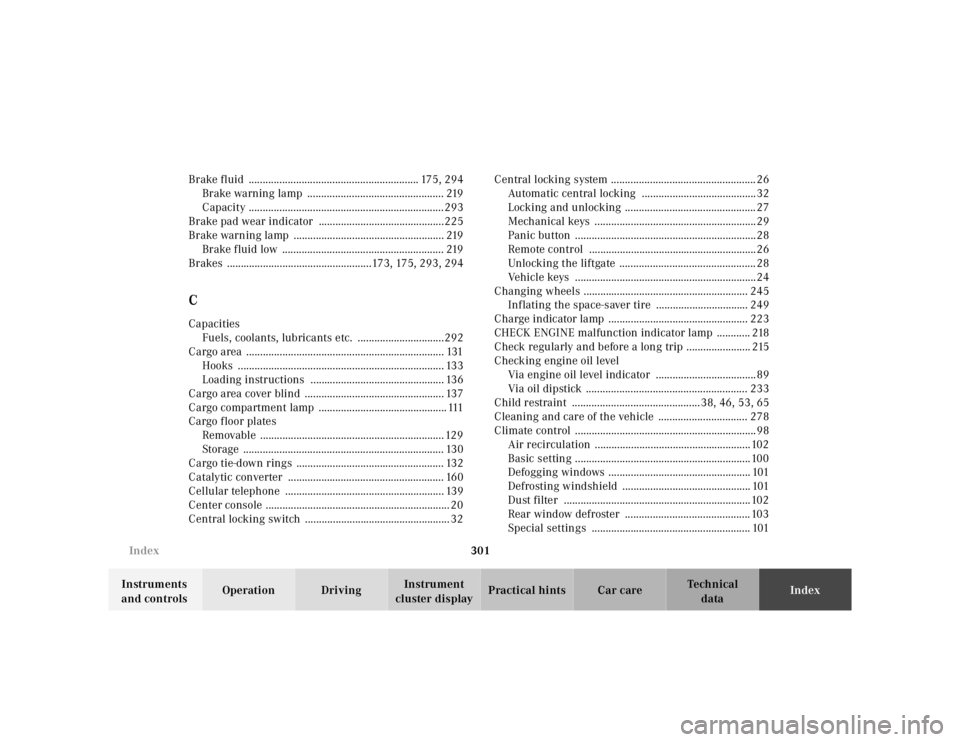
301
Index
Te ch n ica l
data
Instruments
and controls Operation Driving
Instrument
cluster display Practical hints Car care
Index
Brake fluid ............................................................. 175, 294
Brake warning lamp ................................................. 219
Capacity ......................................................................293
Brake pad wear indicator .............................................225
Brake warning lamp ...................................................... 219 Brake fluid low .......................................................... 219
Brakes ....................................................173, 175, 293, 294
CCapacities Fuels, coolants, lubricants etc. ...............................292
Cargo area ....................................................................... 131 Hooks .......................................................................... 133
Loading instructions ................................................ 136
Cargo area cover blind .................................................. 137
Cargo compartment lamp .............................................. 111
Cargo floor plates
Removable .................................................................. 129
Storage ........................................................................ 130
Cargo tie-down rings ..................................................... 132
Catalytic converter ........................................................ 160
Cellular telephone ......................................................... 139
Center console .................................................................. 20
Central locking switch .................................................... 32 Central locking system .................................................... 26
Automatic central locking .........................................32
Locking and unlocking ............................................... 27
Mechanical keys ..........................................................29
Panic button .................................................................28
Remote control ............................................................26
Unlocking the liftgate ................................................. 28
Vehicle keys .................................................................24
Changing wheels ........................................................... 245 Inflating the space-saver tire ................................. 249
Charge indicator lamp .................................................. 223
CHECK ENGINE malfunction indicator lamp ............ 218
Check regularly and before a long trip ....................... 215
Checking engine oil level Via engine oil level indicator ....................................89
Via oil dipstick .......................................................... 233
Child restraint ..............................................38, 46, 53, 65
Cleaning and care of the vehicle ................................ 278
Climate control .................................................................98 Air recirculation ........................................................102
Basic setting ...............................................................100
Defogging windows ................................................... 101
Defrosting windshield .............................................. 101
Dust filter ...................................................................102
Rear window defroster ............................................. 103
Special settings ......................................................... 101
Page 770 of 4133
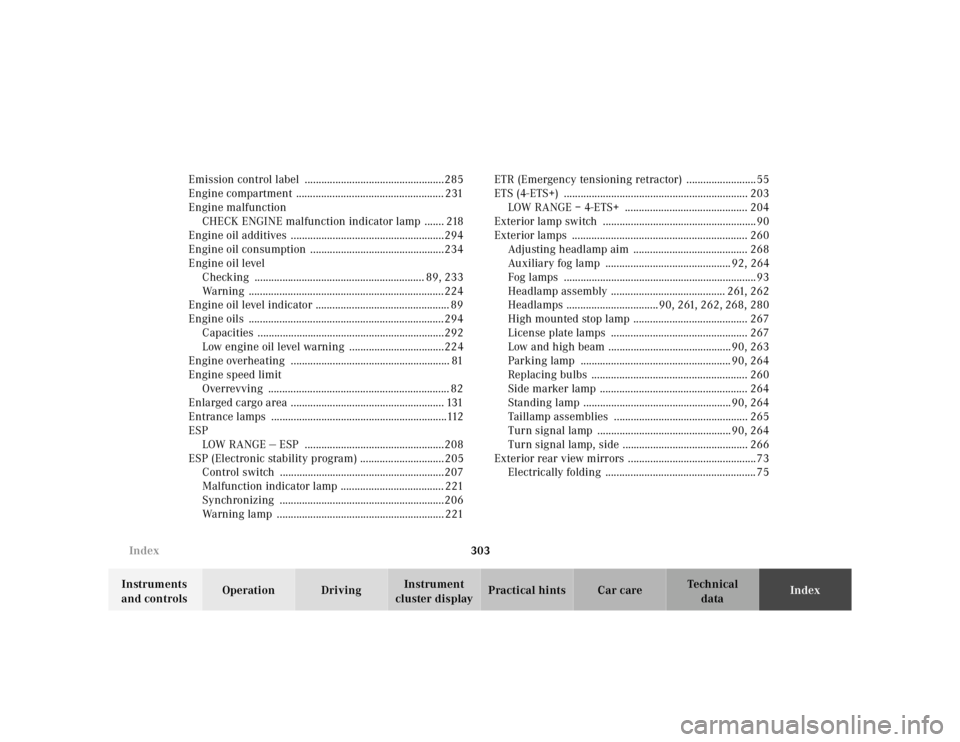
303
Index
Te ch n ica l
data
Instruments
and controls Operation Driving
Instrument
cluster display Practical hints Car care
Index
Emission control label ..................................................285
Engine compartment ..................................................... 231
Engine malfunction CHECK ENGINE malfunction indicator lamp ....... 218
Engine oil additives .......................................................294
Engine oil consumption ................................................234
Engine oil level Checking ............................................................. 89, 233
Warning ......................................................................224
Engine oil level indicator ................................................ 89
Engine oils ......................................................................294 Capacities ...................................................................292
Low engine oil level warning ..................................224
Engine overheating ......................................................... 81
Engine speed limit Overrevving ................................................................. 82
Enlarged cargo area ....................................................... 131
Entrance lamps ...............................................................112
ESP LOW RANGE — ESP ..................................................208
ESP (Electronic stability program) ..............................205 Control switch ...........................................................207
Malfunction indicator lamp ..................................... 221
Synchronizing ...........................................................206
Warning lamp ............................................................ 221 ETR (Emergency tensioning retractor) .........................55
ETS (4-ETS+) .................................................................. 203 LOW RANGE – 4-ETS+ ............................................ 204
Exterior lamp switch .......................................................90
Exterior lamps ............................................................... 260 Adjusting headlamp aim ......................................... 268
Auxiliary fog lamp ............................................. 92, 264
Fog lamps .....................................................................93
Headlamp assembly ......................................... 261, 262
Headlamps .................................90, 261, 262, 268, 280
High mounted stop lamp ......................................... 267
License plate lamps ................................................. 267
Low and high beam ............................................90, 263
Parking lamp ...................................................... 90, 264
Replacing bulbs ........................................................ 260
Side marker lamp ..................................................... 264
Standing lamp .....................................................90, 264
Taillamp assemblies ................................................ 265
Turn signal lamp ................................................90, 264
Turn signal lamp, side ............................................. 266
Exterior rear view mirrors ..............................................73 Electrically folding ...................................................... 75
Page 773 of 4133
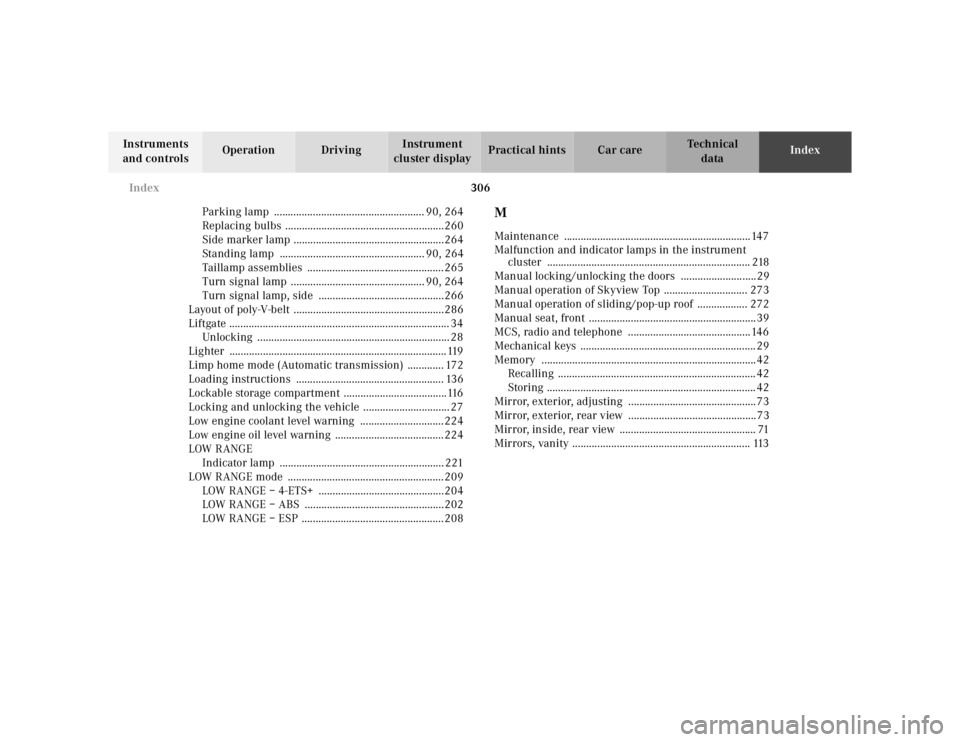
306
Index
Te ch n ica l
data
Instruments
and controls Operation Driving
Instrument
cluster display Practical hints Car care
Index
Parking lamp ...................................................... 90, 264
Replacing bulbs .........................................................260
Side marker lamp ......................................................264
Standing lamp .................................................... 90, 264
Taillamp assemblies .................................................265
Turn signal lamp ................................................ 90, 264
Turn signal lamp, side .............................................266
Layout of poly-V-belt ......................................................286
Liftgate ............................................................................... 34 Unlocking ..................................................................... 28
Lighter ..............................................................................119
Limp home mode (Automatic transmission) ............. 172
Loading instructions ..................................................... 136
Lockable storage compartment .....................................116
Locking and unlocking the vehicle ............................... 27
Low engine coolant level warning ..............................224
Low engine oil level warning .......................................224
LOW RANGE Indicator lamp ........................................................... 221
LOW RANGE mode ........................................................209 LOW RANGE – 4-ETS+ .............................................204
LOW RANGE – ABS ..................................................202
LOW RANGE – ESP ...................................................208
MMaintenance ...................................................................147
Malfunction and indicator lamps in the instrument cluster ......................................................................... 218
Manual locking/unlocking the doors ...........................29
Manual operation of Skyview Top .............................. 273
Manual operation of sliding/pop-up roof .................. 272
Manual seat, front ............................................................39
MCS, radio and telephone ............................................146
Mechanical keys ............................................................... 29
Memory .............................................................................42 Recalling ....................................................................... 42
Storing ........................................................................... 42
Mirror, exterior, adjusting ..............................................73
Mirror, exterior, rear view ..............................................73
Mirror, inside, rear view ................................................. 71
Mirrors, vanity ................................................................ 113
Page 784 of 4133
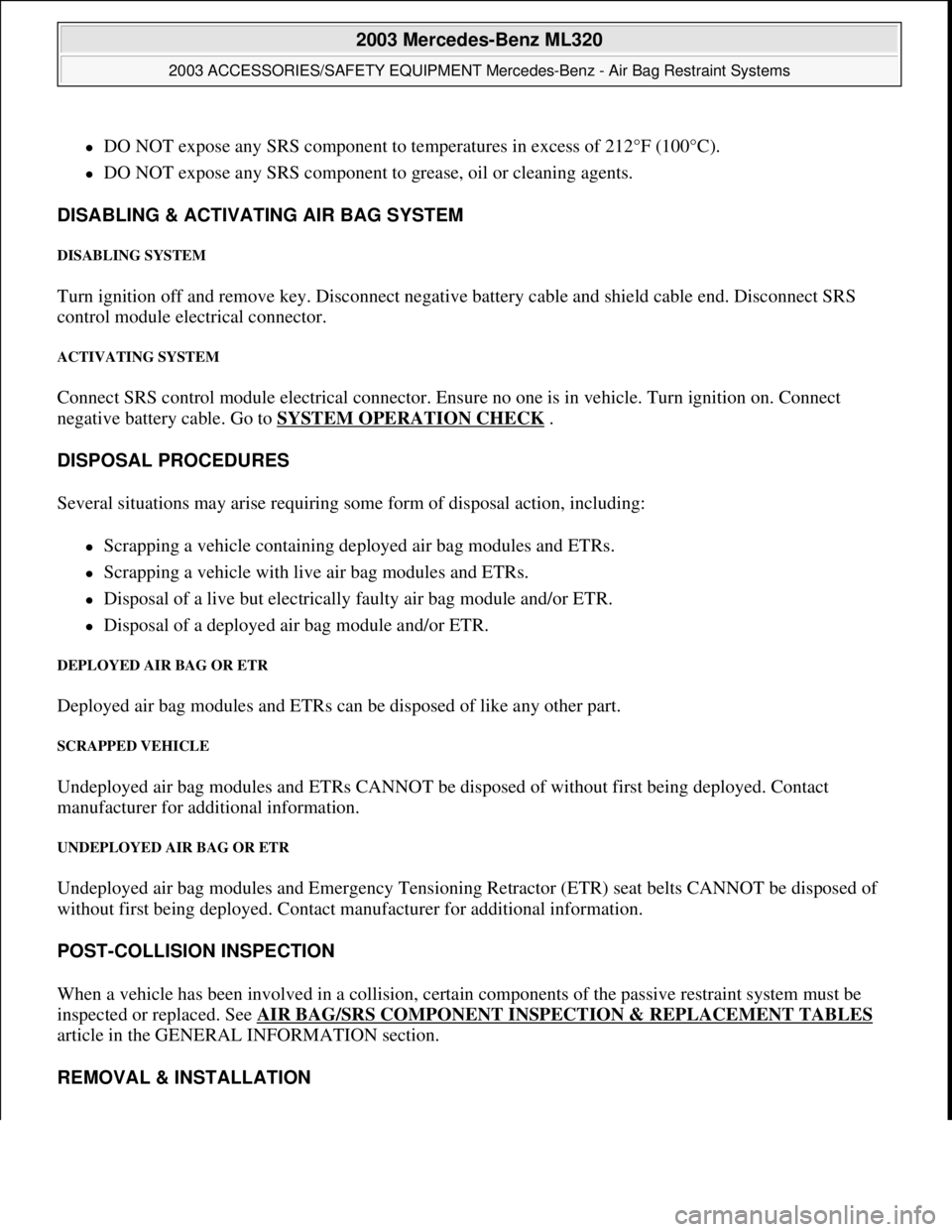
DO NOT expose any SRS component to temperatures in excess of 212°F (100°C).
DO NOT expose any SRS component to grease, oil or cleaning agents.
DISABLING & ACTIVATING AIR BAG SYSTEM
DISABLING SYSTEM
Turn ignition off and remove key. Disconnect negative battery cable and shield cable end. Disconnect SRS
control module electrical connector.
ACTIVATING SYSTEM
Connect SRS control module electrical connector. Ensure no one is in vehicle. Turn ignition on. Connect
negative battery cable. Go to SYSTEM OPERATION CHECK
.
DISPOSAL PROCEDURES
Several situations may arise requiring some form of disposal action, including:
Scrapping a vehicle containing deployed air bag modules and ETRs.
Scrapping a vehicle with live air bag modules and ETRs.
Disposal of a live but electrically faulty air bag module and/or ETR.
Disposal of a deployed air bag module and/or ETR.
DEPLOYED AIR BAG OR ETR
Deployed air bag modules and ETRs can be disposed of like any other part.
SCRAPPED VEHICLE
Undeployed air bag modules and ETRs CANNOT be disposed of without first being deployed. Contact
manufacturer for additional information.
UNDEPLOYED AIR BAG OR ETR
Undeployed air bag modules and Emergency Tensioning Retractor (ETR) seat belts CANNOT be disposed of
without first being deployed. Contact manufacturer for additional information.
POST-COLLISION INSPECTION
When a vehicle has been involved in a collision, certain components of the passive restraint system must be
inspected or replaced. See AIR BAG/SRS COMPONENT INSPECTION & REPLACEMENT TABLES
article in the GENERAL INFORMATION section.
REMOVAL & INSTALLATION
2003 Mercedes-Benz ML320
2003 ACCESSORIES/SAFETY EQUIPMENT Mercedes-Benz - Air Bag Restraint Systems
me
Saturday, October 02, 2010 3:32:07 PMPage 3 © 2006 Mitchell Repair Information Company, LLC.
Page 787 of 4133
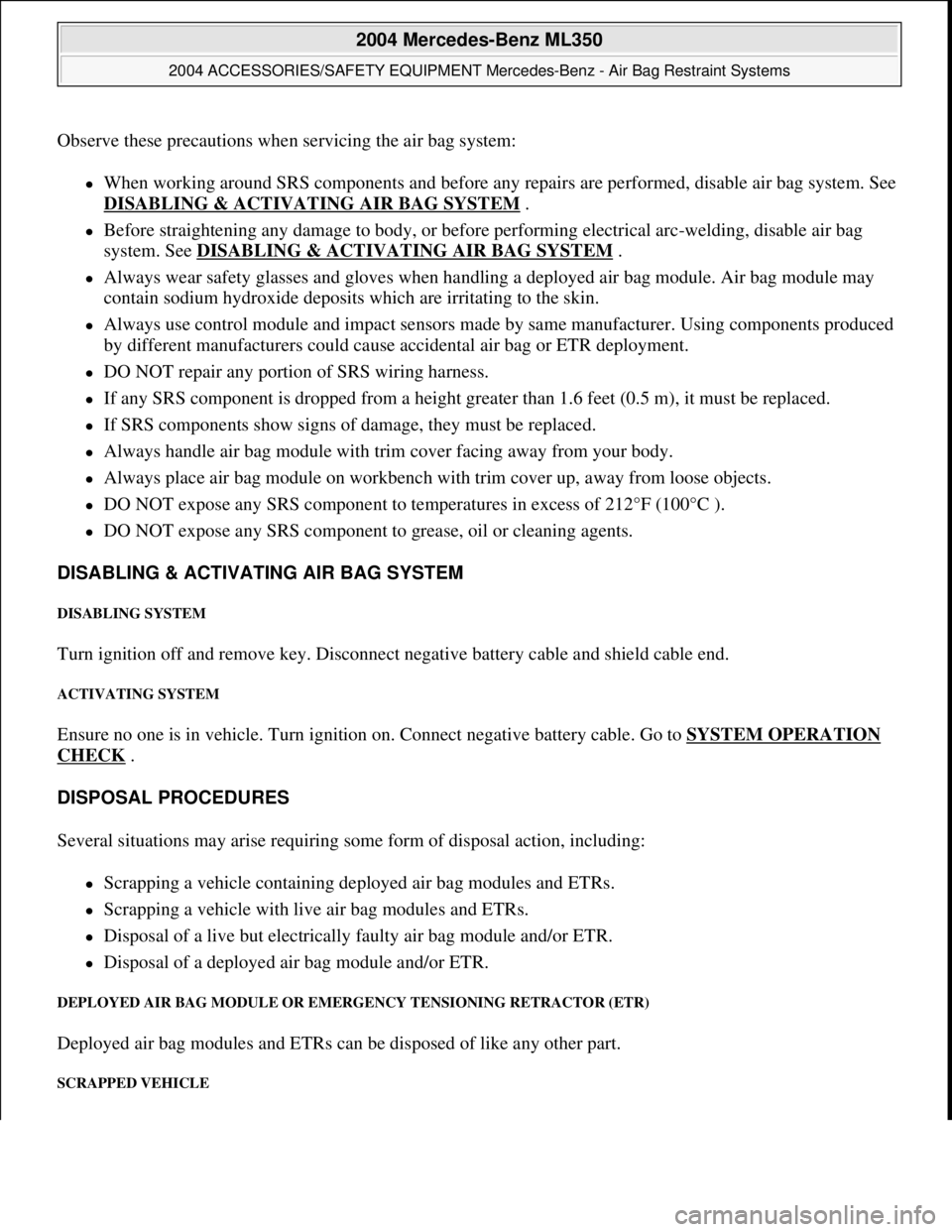
Observe these precautions when servicing the air bag system:
When working around SRS components and before any re pairs are performed, disable air bag system. See
DISABLING & ACTIVATI NG AIR BAG SYSTEM
.
Before straightening any damage to body, or before performing electrical arc-welding, disable air bag
system. See DISABLING & ACTIVATING AIR BAG SYSTEM
.
Always wear safety glasses and gloves when ha ndling a deployed air bag module. Air bag module may
contain sodium hydroxide deposits wh ich are irritating to the skin.
Always use control module and impact sensors made by same manufacturer. Using components produced
by different manufacturers could cause acc idental air bag or ETR deployment.
DO NOT repair any portion of SRS wiring harness.
If any SRS component is dropped from a height greater than 1.6 feet (0.5 m), it must be replaced.
If SRS components show signs of damage, they must be replaced.
Always handle air bag module with tr im cover facing away from your body.
Always place air bag module on workbench with trim cover up, away from loose objects.
DO NOT expose any SRS component to temperatures in excess of 212°F (100°C ).
DO NOT expose any SRS component to grease, oil or cleaning agents.
DISABLING & ACTIVATI NG AIR BAG SYSTEM
DISABLING SYSTEM
Turn ignition off and remove key. Disconnect ne gative battery cable and shield cable end.
ACTIVATING SYSTEM
Ensure no one is in vehicle. Turn ignition on. Connect negative battery cable. Go to SYSTEM OPERATION
CHECK .
DISPOSAL PROCEDURES
Several situations may arise requiring so me form of disposal action, including:
Scrapping a vehicle containing deployed air bag modules and ETRs.
Scrapping a vehicle with live air bag modules and ETRs.
Disposal of a live but electrically faulty air bag module and/or ETR.
Disposal of a deployed air bag module and/or ETR.
DEPLOYED AIR BAG MODULE OR EMERGENCY TENSIONING RETRACTOR (ETR)
Deployed air bag modules and ETRs can be disposed of like any other part.
SCRAPPED VEHICLE
2004 Mercedes-Benz ML350
2004 ACCESSORIES/SAFETY EQUIPMENT Merce des-Benz - Air Bag Restraint Systems
me
Saturday, October 02, 2010 3:40:40 PMPage 2 © 2006 Mitchell Repair Information Company, LLC.